There are endless things to do in Guernsey – an island that was never on my list until I visited.
I didn’t know what to expect and I certainly didn’t think I’d fall in love with it.
Guernsey has that effect.
Turquoise waters, quiet villages and experiences you won’t find anywhere else.
Beaches that look like postcards. Watersports that get your heart racing. Streets so peaceful you can actually hear yourself think.
And don’t even get me started on the Guernsey cows. It’s impossible not to adore them.
I was surprised at every turn. Secret coves. Historic gems. So much beauty waiting to be discovered. You’ll be snapping photos non-stop. I certainly did.
There are so many amazing things to do in Guernsey – and trust me, you’ll want to see them all.
If you’re planning a visit, my Guernsey itinerary takes you through the best way to spend five unforgettable days on the island.

Affiliate links ahead in this post. Your clicks may earn me a commission at no extra cost to you, which keeps this site online and the ideas coming. Thanks for being part of it.
| Booked It, Loved It: My Guernsey Picks Where To Stay: The Peninsula Hotel and Fermain Valley Hotel Highlights: Half-Day Shore Excursion and Coastal Highlights Tour Travel Insurance: Safety Wing |
Guernsey at a Glance: Quick Facts Before You Go
Before we dive into all the wonderful things to do in Guernsey, here’s a handy at-a-glance guide with the essentials.
| Info | Details |
|---|---|
| Currency | Guernsey pound (UK pounds accepted everywhere) |
| Language | English |
| Population | ~63,000 |
| Time zone | GMT |
| Flight time from UK | ~1 hour |
| Ferry options | From Poole & Portsmouth |
| Best months to visit | May–September |
| Car hire | Recommended for exploring hidden coves and beaches |
| Top nearby islands | Herm, Sark |
▶ A Taste of Guernsey: 2-Day Sample Itinerary
Day 1
- Explore St Peter Port: cobbled streets, pastel houses, and Castle Cornet
- Visit the quirky Little Chapel
- Wander around Moulin Huet for stunning coastal views
Day 2
- Spend the morning at the beaches – Vazon Bay or Fermain Bay
- Optional ferry trip to Herm for turquoise waters and white sands
- Afternoon coffee or cake at a local café
What You Need To Know About Guernsey
Guernsey is part of the British Isles, sitting in the Channel but closer to France than England.
English is spoken everywhere and the vibe feels very British – but with its own twist. Around 63,000 people call the island home, which gives it that lovely small-community feel.
The island even has its own currency: the Guernsey pound. It looks different but works the same, and your UK cash is accepted too.
One thing I really loved – there are no fast-food chains here. None. Instead, it’s all about locally sourced food and independent cafes. Honestly, it makes eating out feel more special.
A little history nugget for you: Guernsey was once the tip of a peninsula attached to mainland Europe.
Rising sea levels cut it off from France about 8,000 years ago.
This probably explains why it feels a little bit like France and a little bit like Britain – but also entirely its own thing.
And yes, we’re back to the cows – because hello, I’m obsessed with them. Guernsey cows are famous for their creamy milk, which makes everything from butter to ice cream taste unreal.
Here’s another fun fact: spring actually arrives four weeks earlier in Guernsey than on mainland Britain.
That means the island bursts into colour before the rest of us, with unique and beautiful flowers everywhere you look.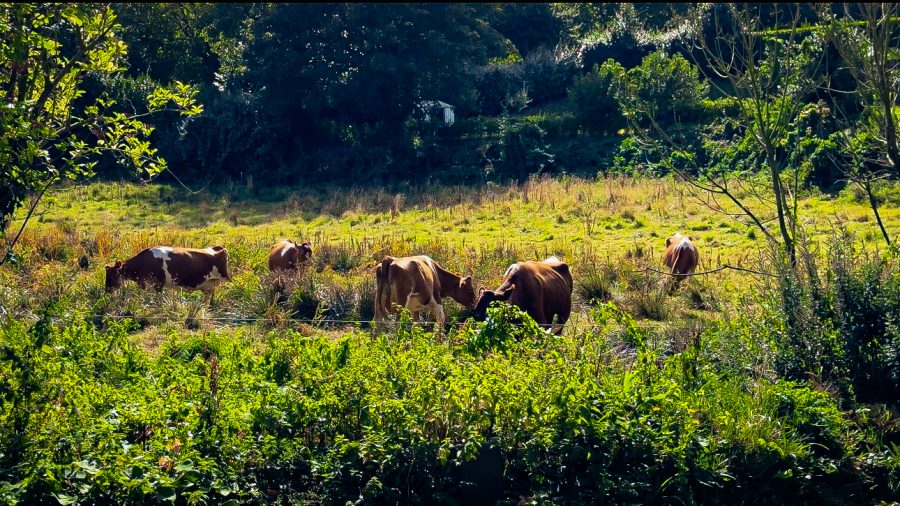
How to Get To Guernsey
Getting to Guernsey couldn’t be easier.
Flights from multiple UK airports take just over an hour, which means you can be in island mode before you know it.
Seriously, no long-haul stress – just quick, easy travel.
If you fancy a slower pace, you can catch a ferry. They run from Poole and Portsmouth, giving you a little sea breeze before you arrive.
Honestly, that’s part of what makes Guernsey such a great escape – an hour from the UK and suddenly you’re somewhere completely different. Calm, relaxed and ready for all the things to do in Guernsey.
Getting Around On The Island
The easiest way to get around Guernsey is by car.
The island isn’t big, so drives are short. Having your own wheels means you can hunt out hidden coves, quiet villages, and those picture-perfect beaches.
Just a heads-up though – the roads are seriously narrow. Passing places are common, so take it slow and enjoy the views.
The speed limit is 35mph across the island, which actually makes driving pretty chilled.
If you don’t drive, don’t despair.
There are buses that cover most of the island and taxis too, but be aware they can take time, especially at night. Plan ahead so you’re not stuck waiting.
But honestly, nothing beats the freedom of exploring at your own pace with a car. It lets you explore all the best things to do in Guernsey without worrying about schedules.
Where to Stay in Guernsey
I stayed at two hotels that I’d happily recommend.
The Peninsula Hotel has that classic seaside vibe and sits right on the west coast by Vazon Bay.
Waking up to the sea outside your window never gets old.
The food is excellent, with a varied menu and a breakfast spread that has both hot and cold options – perfect fuel for a day exploring the island.
Fermain Valley Hotel is more of a treat, located near the south coast. It has stunning views over Fermain Valley and the sea beyond.
Comfy rooms, a touch of luxury and amazing food make it ideal if you want something special.
Breakfast is a highlight here too, with plenty of options to start the day right.
Both give you a fantastic base to explore Guernsey at your own pace.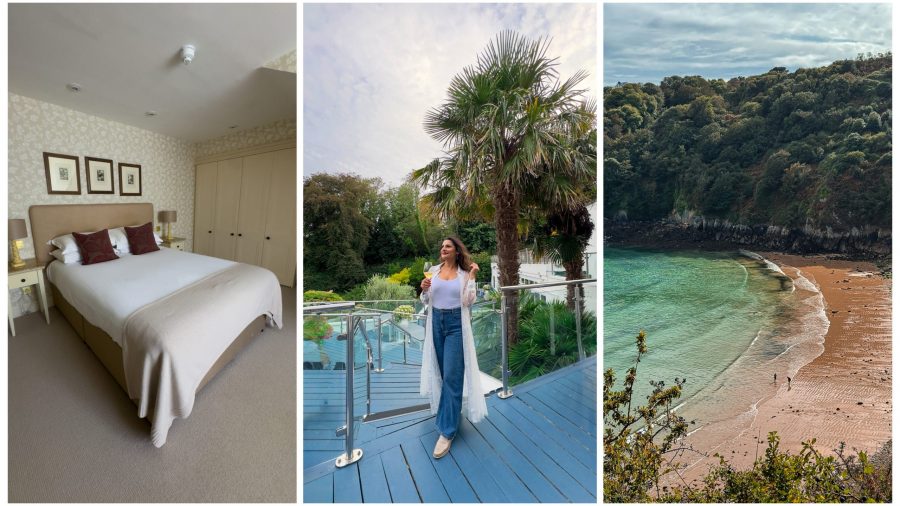
Epic Things to Do in Guernsey
Here are the top things to do in Guernsey; the spots, experiences and moments that make the island unforgettable.
Visit the Little Chapel
The Little Chapel is one of the quirkiest, most charming places on the island. Built by a monk in the early 1900s, it’s tiny – so tiny you might have to duck to get inside.
What makes it magical are the walls. They’re covered in mosaics made from broken china, shells and glass. Every corner sparkles. It feels whimsical, like something out of a fairy tale.
One of my friends in our group said it reminded them of a little gingerbread house.
It doesn’t take long to explore, but it’s one of the most unique things to do in Guernsey.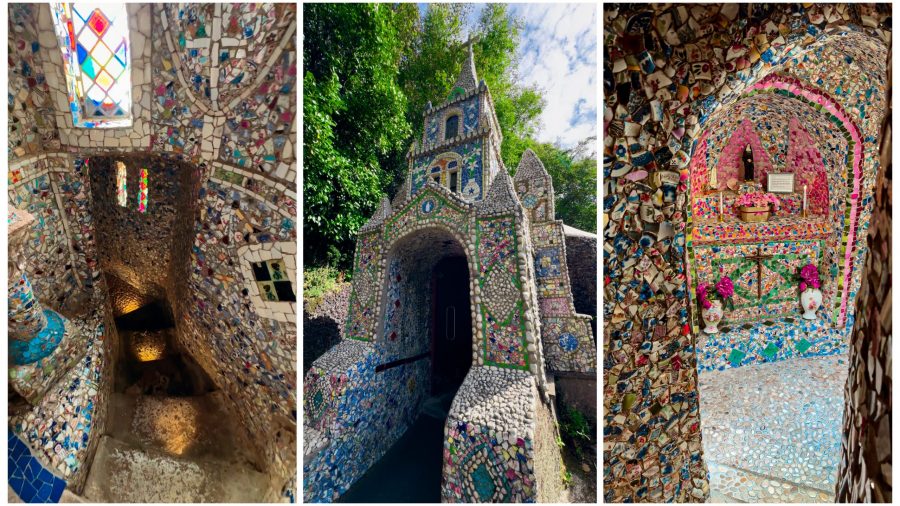
Step Inside the Underground Hospital
History lovers, this one’s for you. Guernsey was occupied during World War II, and the Underground Military Hospital is a stark reminder of that time.
Built by prisoners of war, it’s carved into the rock and stretches for hundreds of metres.
Walking through the tunnels feels eerie. The air is cool, the walls damp. You can almost imagine what life was like down here.
Back then, conditions were tough. Prisoners and patients often fell ill in the damp, cramped tunnels.
It’s haunting but fascinating – one of the most powerful historic sites on the island.
Postcard Beaches
Guernsey’s beaches really steal the show. Each one has its own charm, and you’ll want to explore them all.
Vazon Bay – Wide, sandy, and perfect for watersports. Surf, paddleboard, or even try kite surfing if you’re feeling brave.
Moulin Huet – My personal favourite. Renoir stayed here and painted this cove, and it’s easy to see why. Light, water, cliffs – totally picture-perfect. Treat yourself to tea and cake at Renoir Tea Rooms after exploring.
Fermain Bay – More tucked away, with turquoise water and pebbles. Feels almost secret, ideal for a peaceful swim or a lazy afternoon.
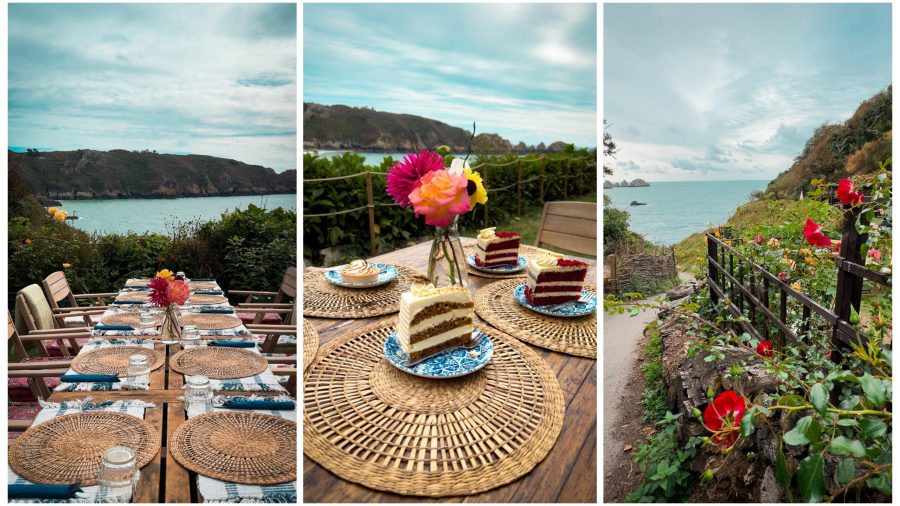
Explore St Peter Port
Guernsey’s capital is picture-perfect.
Cobbled streets, pastel-coloured houses and a bustling harbour.
Wander around the shops, pop into the cafes or just watch the boats coming and going.
Don’t miss Castle Cornet, a fortress that’s been guarding the harbour for 800 years. The cannons are still fired daily.
St Peter Port is also your gateway to the other islands.
Ferries run to Herm, Sark and even smaller islets if you fancy a day trip or overnight adventure.
Each island has its own unique charm and the boat ride offers gorgeous views along the way.
Tip: Ferries can fill up quickly, especially in summer, so it’s best to book ahead. That way, you can make the most of your island-hopping without worrying about missing out.

Do the Renoir Walk
Art lovers, this one’s for you.
Back in 1883, Renoir spent a month at Moulin Huet, capturing the island’s coastal charm in his paintings.
The Renoir Walk lets you follow in his footsteps. Five frames are placed along the trail, each marking the exact spot where he painted.
Peek through them, and you can see the landscape almost as he did over a century ago.
It’s a brilliant way to mix a bit of history, art and fresh sea air – and the scenery along the Moulin Huet trail is truly stunning.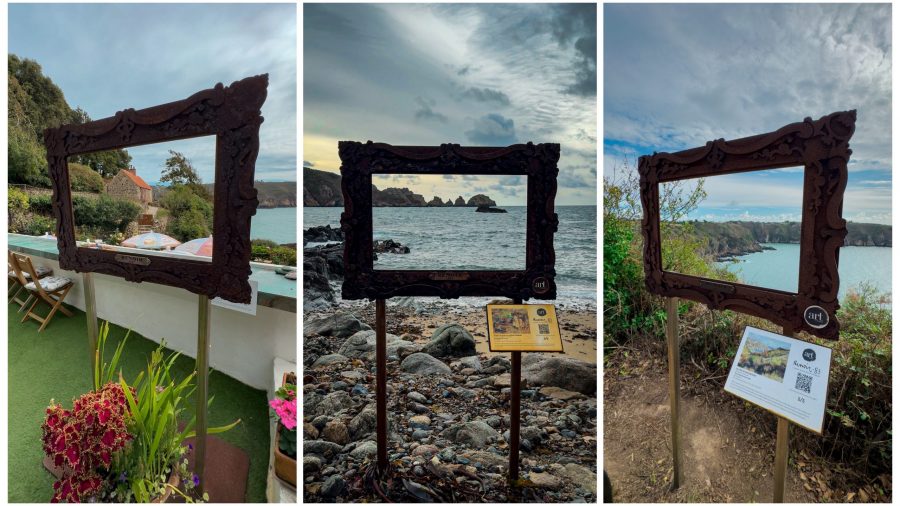
Try Watersports
Guernsey is known for its watersports. Whether you’re a pro or a total beginner, there’s something to try.
Surf at Vazon, paddleboard in calm coves or kayak along the cliffs.
The water is so clear and blue, you’ll feel like you’re somewhere much further afield.
Island Hop to Herm or Sark
One of the best things to do in Guernsey is to use it as a base for island hopping.
Herm is tiny, with white sandy beaches that could be mistaken for the Caribbean.
No cars, no residents, and only about 35 people who work on the island. With just one hotel, it’s all about peace, quiet and turquoise waters.
Sark feels like stepping back in time. No cars here either – just bikes and horse-drawn carts.
With only around 500 residents, the island’s rugged, wild landscapes are perfect for walking and truly switching off.
Whether you go for a day trip or overnight, both islands are unforgettable. If you want to know more about visiting Sark, check out my full guide here.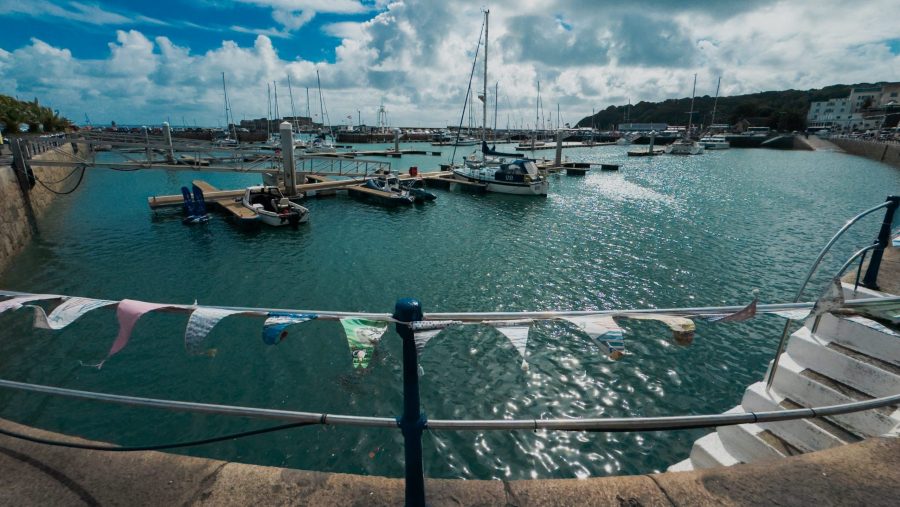
Eat Local
Food in Guernsey is special. With no fast-food chains, everything is about local produce and independent places.
Seafood is a must – crab, lobster and scallops are fresh and delicious.
Guernsey’s dairy is world-famous, so don’t skip the ice cream.
And the island’s bakeries? Dangerous in the best way. Think fresh bread, buttery pastries and proper comfort food.
Eating here feels authentic – like every meal has a story.

| Tips For Visiting Guernsey Roads are narrow – take it slow and enjoy the views. Book ferries in advance if you’re heading to Herm or Sark. Beaches are quietest early morning or late afternoon. Locally sourced food is amazing – skip fast food, enjoy cafés and bakeries. Spring arrives 4 weeks earlier than mainland UK – perfect for flowers and mild weather. |
FAQs About Visiting Guernsey
Can I use British pounds in Guernsey?
Yes! Guernsey has its own currency, the Guernsey pound, but UK pounds are accepted everywhere. Super easy – no need to swap cash if you don’t want to.
Do Brits need a passport for Guernsey?
No, UK citizens don’t need a passport, but you do need some form of photo ID. A driving licence works perfectly for adults.
How many days do you need in Guernsey?
You can see the highlights in 2–3 days, but 4–5 days gives you time to explore beaches, villages, and even take a day trip to Herm or Sark.
Is Guernsey expensive?
It’s not cheap, but it’s not outrageous either. Expect mid-range prices for food, accommodation, and activities. Treat yourself to a couple of local experiences – it’s worth it.
What is the best month to visit Guernsey?
May to September is ideal. The weather is mild, flowers are in bloom, and the island is lively without being overcrowded.
What is the prettiest part of Guernsey?
Moulin Huet, Fermain Bay, and the west coast around Vazon Bay are incredibly scenic. For pastel-coloured streets and harbour views, St Peter Port is a delight too.
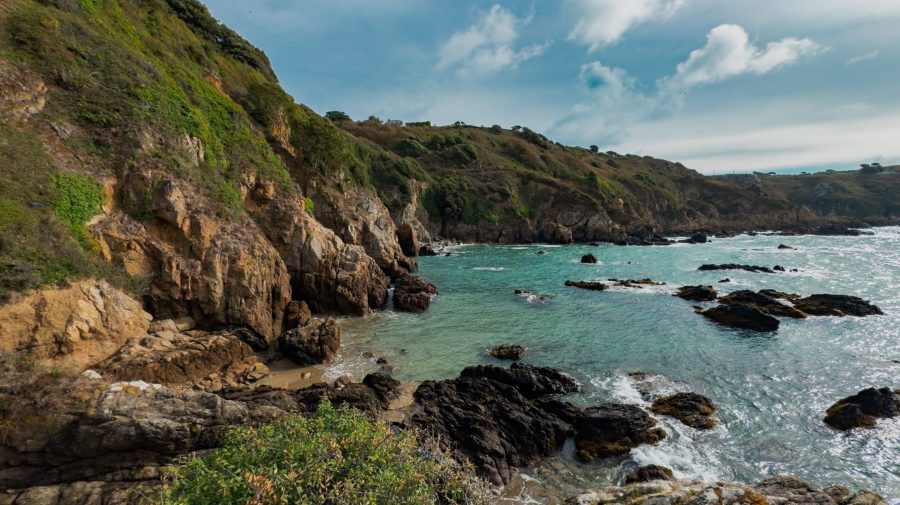
Why Guernsey Should Be on Your List
Guernsey isn’t just pretty beaches and cows (though they’re reason enough). It’s history, art, adventure and food – all packed into one small island.
It’s easy to get to, easy to get around and full of surprises. Frankly, it’s a no-brainer. If you’re after something different, something that feels both familiar and new, Guernsey is it.
Check out my Guernsey itinerary to plan the perfect five days.
And trust me, once you’ve been, you’ll wonder why it wasn’t on your list sooner. If you enjoy island escapes like Guernsey, you might also enjoy my guide to Malta.

